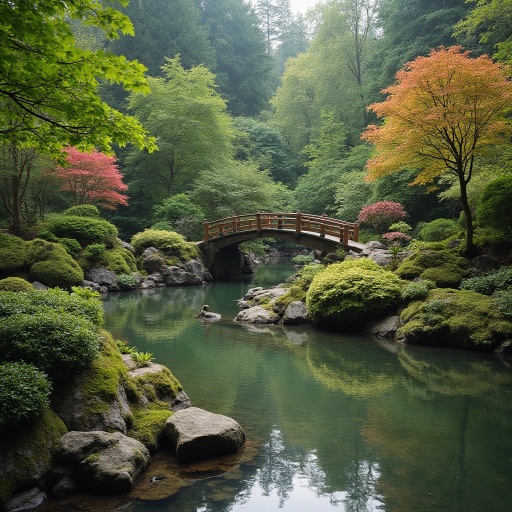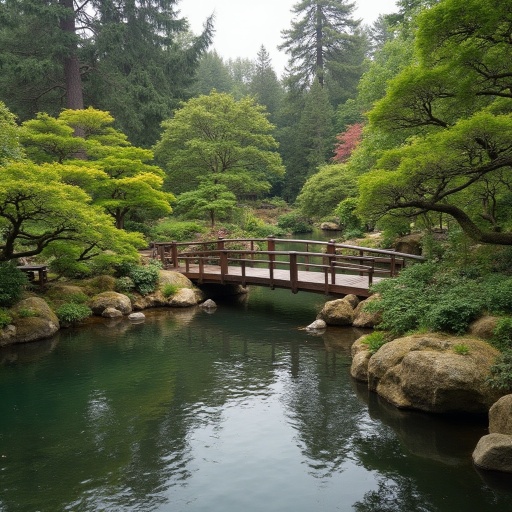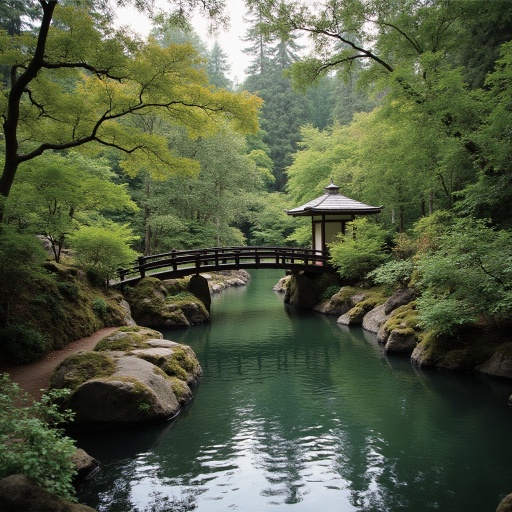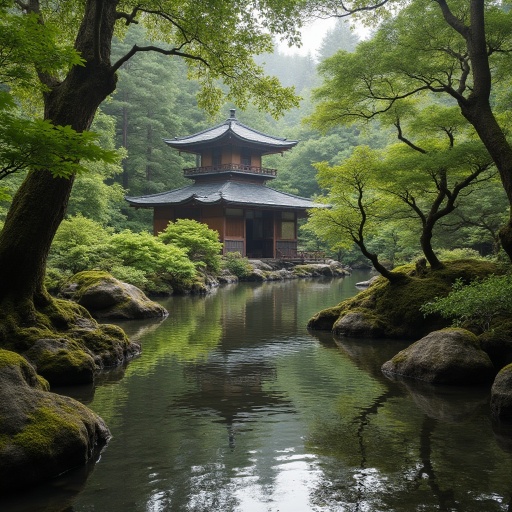Portland Japanese Garden: Timeless Garden Design Ideas for Your Landscape

Did you know that visitors who spend time in Japanese gardens experience a 27% greater reduction in stress hormones compared to those who visit other garden styles? The Portland Japanese Garden stands as a living testament to this powerful effect, offering not just tranquility but also countless garden design ideas that can transform any outdoor space. Recognized as the most authentic Japanese garden outside of Japan, this 12-acre sanctuary has been inspiring landscape designs since 1967. Whether you’re seeking to incorporate Japanese aesthetics into your home garden or simply appreciate the art of landscaping, the Portland Japanese Garden offers principles and techniques that transcend cultural boundaries.
Essential Information About Portland Japanese Garden
The Portland Japanese Garden represents one of the finest examples of Japanese gardening outside of Japan, featuring eight distinct garden spaces within its 12-acre grounds. Located in Washington Park on the west hills of Portland, Oregon, the garden provides both intimate and panoramic views that demonstrate masterful landscape designs for various settings:
- Flat Garden (Hira-niwa): Showcases the art of asymmetrical balance with carefully placed stones, pruned shrubs, and raked gravel patterns
- Strolling Pond Garden (Chisen-kaiyu-shiki): Demonstrates water-centered garden design with bridges, stepping stones, and layered plantings
- Tea Garden (Roji): Illustrates the minimalist approach to garden design with moss groundcover and strategic stone placement
- Natural Garden (Shukeiyen): Exemplifies the naturalistic style of landscaping with native plants and seemingly untamed aesthetics
- Sand and Stone Garden (Karesansui): Reveals how abstract representations of nature can create powerful garden spaces
Each area offers unique landscape designs that can inspire home gardeners to incorporate elements of Japanese gardening philosophy, from careful plant selection to thoughtful stone placement. Visitors consistently rank the Portland Japanese Garden among the top Japanese gardens globally, with principles that can be adapted to gardens of any size or geographical location.
Timing
A complete exploration of the Portland Japanese Garden typically requires 2-3 hours, though garden design enthusiasts often spend up to 4 hours studying specific landscaping techniques and plant arrangements. According to visitor data, the average visit lasts 2.5 hours, with first-time visitors spending approximately 30 minutes longer than repeat guests. The garden’s relatively compact size allows for multiple circuits, giving visitors the opportunity to observe the same spaces from different perspectives—an important aspect of Japanese garden design philosophy.
For those specifically focused on gathering landscape design ideas, consider allocating extra time in the Cultural Village to view exhibitions and attend demonstrations. Seasonal visits are also recommended, as the garden’s appearance transforms dramatically throughout the year, demonstrating how effective garden design accounts for year-round appeal.
Step-by-Step Garden Design Exploration
Step 1: Begin at the Cultural Village
Start your garden design journey at the Cultural Village, designed by renowned Japanese architect Kengo Kuma. This modern interpretation of traditional Japanese architecture demonstrates how built structures can complement and enhance landscaping designs. Notice how the buildings’ clean lines frame garden views and create transitions between spaces. The cascading water feature here illustrates how sound can be incorporated as an essential element in garden design, blocking urban noise while creating a sense of movement.
Before moving deeper into the garden, visit the Pavilion Gallery where rotating exhibitions often focus on aspects of Japanese garden design. The resource library also offers materials on landscaping techniques that can be referenced after your visit. Pro tip: Take a few minutes to photograph the garden map or save it to your phone—this will help you navigate intentionally rather than missing key design elements.
Step 2: Explore the Flat Garden for Design Composition
Proceed to the Flat Garden (Hira-niwa), where you’ll observe one of the clearest expressions of Japanese garden design principles. This garden demonstrates how carefully positioned elements create a living landscape painting. Notice the asymmetrical balance—a key aspect of Japanese garden design that feels more natural than rigid symmetrical layouts. Pay attention to the careful pruning techniques that create depth and perspective in a relatively small space.
Take photographs from multiple angles to understand how different viewpoints were considered in the design process. The white gravel represents water and demonstrates how symbolic elements can replace literal ones—an important concept for water-conscious landscape designs. Study how evergreen plants of varying textures create year-round interest, a technique easily adaptable to home gardens.
Step 3: Study Water Integration in the Strolling Pond Garden
Next, visit the Strolling Pond Garden (Chisen-kaiyu-shiki) to observe masterful water integration in garden design. This two-part garden showcases how water features can be the centerpiece of landscaping designs. Note how plants are arranged to reflect in the water, effectively doubling their visual impact. The Moon Bridge demonstrates how garden structures can serve both functional and aesthetic purposes, encouraging visitors to pause and observe the landscape from new perspectives.
Pay particular attention to the shoreline details—the arrangement of stones at the water’s edge, the strategic placement of ornamental plants, and the use of negative space. These techniques can be scaled down for home water features of any size. For practical application, photograph transitions between different materials and how elevational changes are managed with stone arrangements.
Step 4: Discover Simplicity in the Tea Garden
Continue to the Tea Garden (Roji), where you’ll learn how restraint creates powerful garden design. This area demonstrates that effective landscaping doesn’t require elaborate plantings or structures. Observe the limited plant palette and how moss serves as a versatile groundcover that adds texture and captures moisture. The stepping stone path illustrates how circulation patterns can enhance the garden experience, forcing visitors to slow down and observe their surroundings.
Make note of the careful maintenance techniques that keep the garden looking simultaneously natural and controlled. The lanterns and stone basins show how functional elements can serve as focal points in minimalist landscape designs. This garden offers particularly valuable lessons for small space gardening, demonstrating how careful editing creates more impactful landscapes than overcrowding.
Step 5: Reflect and Document Design Elements for Home Application
Complete your garden design study at the Umami Café, where floor-to-ceiling windows provide panoramic views across the garden. This vantage point allows you to observe the entire composition and understand how individual garden spaces connect to form a cohesive landscape design. Use this time to organize your notes and photographs, categorizing design elements that could be adapted to your own garden.
Before leaving, visit the gift shop to explore books on Japanese gardening principles and tools that can help implement specific techniques. Consider purchasing a guide to Japanese plants suitable for your climate zone, as proper plant selection is fundamental to successful garden design. Create a list of three specific design elements you found most inspiring and develop a plan to incorporate them into your home landscape.

Technical and Artistic Information
The Portland Japanese Garden was founded in 1963 by local community leaders seeking to build cultural ties with Japan, though it didn’t open to the public until 1967. Professor Takuma Tono of Tokyo Agricultural University created the original garden design. Located in Washington Park at 611 SW Kingston Avenue in Portland, Oregon, the garden sits at approximately 500 feet above sea level on a hillside with western exposure, encompassing 12 acres of carefully designed space.
Portland’s climate features mild, wet winters (average 40°F) and warm, dry summers (average 75°F), closely mirroring parts of Japan and creating ideal conditions for many traditional Japanese garden plants. The garden receives approximately 36 inches of rainfall annually, with natural springs and constructed waterways managing hydration throughout the grounds. Water conservation techniques include strategic rainwater collection and recycling systems that support the garden’s numerous water features while demonstrating sustainable landscape design.
The garden’s mission emphasizes cultural understanding through landscape design, with objectives that include:
- Preserving and sharing authentic Japanese gardening traditions
- Demonstrating adaptable landscape design principles for home gardens
- Educating visitors about the cultural significance of garden elements
- Showcasing sustainable gardening practices through traditional techniques
- Providing a space for cultural exchange and appreciation
The garden comprises eight distinct spaces, each with unique characteristics:
- Flat Garden (Hira-niwa): Features meticulously raked white gravel representing water, showcasing the karikomi pruning technique where plants are shaped into undulating forms resembling mountains and hills. Key plants include Japanese maple (Acer palmatum), azalea (Rhododendron spp.), and Japanese black pine (Pinus thunbergii).
- Strolling Pond Garden (Chisen-kaiyu-shiki): Divided into upper and lower sections connected by a flowing stream, featuring Japan’s most iconic garden style. Architectural elements include the Moon Bridge (engetsu-kyo) and zig-zag Bridge (yatsuhashi). Notable plants include water iris (Iris ensata), Japanese forest grass (Hakonechloa macra), and weeping cherry (Prunus subhirtella ‘Pendula’).
- Tea Garden (Roji): Designed to prepare visitors mentally for the tea ceremony, featuring minimal plantings and a roji (dewy path) leading to the authentic Tea House. Key elements include stone water basins (tsukubai), stone lanterns (ishi-doro), and moss groundcover representing 20+ species.
- Natural Garden (Shukeiyen): The newest garden area, emphasizing naturalistic design with native plants and seemingly wild arrangements. Notable features include stone stream beds (kare-nagare), bamboo groves, and mixed woodland plantings.
- Sand and Stone Garden (Karesansui): A dry landscape garden representing abstract natural scenes through carefully placed stones and raked gravel. The garden demonstrates how effective design can create depth and movement without using actual plants or water.
The garden’s distinctive advantages include:
- Authentic design by Japanese landscape architects
- Strategic placement on a hillside allowing for diverse microclimates
- Integration of Mount Hood views into the landscape design
- Ability to demonstrate adaptable techniques for Pacific Northwest gardens
- Exceptional moss collections benefiting from Portland’s climate
Infrastructure includes:
- Cultural Village designed by Kengo Kuma, completed in 2017
- Jordan Schnitzer Japanese Arts Learning Center
- Pavilion Gallery featuring rotating exhibitions
- Kashintei Tea House (authentic Japanese construction)
- Umami Café offering traditional tea service
- Garden Gift Shop with curated Japanese items
- Multiple viewing pavilions and rest areas
- ADA-accessible routes throughout most garden areas
- Comprehensive stormwater management systems
The garden hosts numerous cultural events annually:
- Cherry Blossom Festival (March-April)
- O-Tsukimi (Moonviewing Festival) in September
- Chrysanthemum Display (October-November)
- Kadomatsu (New Year’s decoration) in December-January
- Monthly tea ceremonies and demonstrations
- Special art exhibitions focusing on Japanese culture
Visitor access information:
- Open daily except Thanksgiving and Christmas
- Summer hours (March-October): 10am-7pm
- Winter hours (November-February): 10am-4pm
- Admission: $18.95 for adults, $16.95 for seniors, $15.95 for students, $13.95 for youth
- Members receive free admission and special event access
- Advance timed tickets recommended during peak season
The garden is managed by a non-profit organization with a CEO and Board of Trustees, employing approximately 75 staff members including specialized garden maintainers trained in Japanese gardening techniques. The maintenance team follows traditional Japanese gardening practices, including daily raking of gravel areas, seasonal pruning cycles, and meticulous moss care.
Visitor demographics include approximately 450,000 annual visitors, with 70% from outside Oregon. International visitors constitute about 15% of attendees, with significant numbers from Japan, China, and European countries. The garden has been recognized as a major cultural attraction in Portland, contributing an estimated $18.5 million annually to the local economy.

Healthy Alternatives to Traditional Garden Visits
While the Portland Japanese Garden offers unparalleled access to authentic Japanese landscape designs, consider these alternative experiences to complement your garden education:
- Lan Su Chinese Garden in downtown Portland provides comparative Asian garden design styles, demonstrating how different cultural approaches solve similar landscape challenges
- The Oregon Garden in Silverton showcases native plant landscape designs appropriate for regional gardens
- Portland’s Crystal Springs Rhododendron Garden offers specialized plant collection insights
- Local garden tours organized by the Hardy Plant Society of Oregon provide access to private gardens with Japanese-inspired elements
- Virtual garden design workshops offered by the Portland Japanese Garden’s education department allow for deeper study of specific techniques
For families with diverse interests, consider these adaptations:
- Combine your garden visit with exploration of adjacent Washington Park attractions
- Schedule your visit during hands-on family workshops where children can participate in Japanese cultural activities
- Use the garden’s family exploration guides to engage younger visitors in garden discovery
- Visit during seasonal festivals when additional activities complement garden exploration
- Consider splitting your group, with design enthusiasts taking a guided tour while others explore at their own pace
Introductory Suggestions for First-Time Visitors
For maximum appreciation of the garden’s design elements, consider these approaches for your visit:
Begin your exploration early in the morning when visitor numbers are lowest, allowing unobstructed views and photographs of key garden design features. If possible, schedule your visit on a weekday rather than a weekend. Consider the garden’s seasonal highlights when planning: spring cherry blossoms, summer moss vibrancy, fall maple colors, or winter structural elements.
For personalized experiences:
- Photography enthusiasts should bring both wide-angle and macro lenses
- Garden designers should carry a sketchbook for quick notation of plant arrangements
- Those interested in technical aspects should join a guided tour with a garden curator
- Cultural enthusiasts might coordinate their visit with a traditional tea ceremony
- First-time gardeners should focus on the Natural Garden for more adaptable ideas
Common Mistakes to Avoid
When seeking garden design inspiration at the Portland Japanese Garden, avoid these common pitfalls:
- Rushing through spaces: Visitor surveys indicate that guests who spend less than 15 minutes in each garden area report 40% lower satisfaction and fewer applicable design ideas. Japanese gardens are designed for contemplative viewing—allow sufficient time in each space.
- Missing seasonal variations: Many visitors only see the garden during peak tourist season, missing how effective garden design accounts for year-round interest. If possible, plan multiple visits across different seasons.
- Overlooking maintenance requirements: The garden’s immaculate appearance requires intensive care that may not be realistic for home gardens. Speak with staff about modified approaches for residential landscapes.
- Attempting to replicate rather than adapt: According to garden staff, the most successful home adaptations incorporate Japanese principles rather than attempting exact replications. Focus on concepts like asymmetry, restraint, and borrowed scenery rather than specific plants or structures.
- Neglecting the cultural context: The garden’s design elements carry cultural significance that enhances their impact. Take time to read educational materials explaining the meaning behind design choices.
Visitor Encouragement Tips
To maximize your garden design inspiration at the Portland Japanese Garden:
Attend one of the garden’s demonstration sessions on Japanese pruning techniques, which occur weekly during summer months. These hands-on demonstrations provide practical skills for maintaining Japanese-inspired landscape designs at home. Consider downloading the garden’s mobile app before your visit, which offers detailed information about plant specimens and design elements.
For deepening your garden design understanding:
- Visit during different weather conditions—rainy days highlight water features and moss textures
- Bring a measuring tape to document proportions of features you might want to recreate
- Photograph the same locations from multiple angles to understand viewpoint considerations
- Pack a small notebook to sketch layout ideas and plant combinations
- Consider joining the garden’s membership program for repeat visits throughout the year
Conclusion
The Portland Japanese Garden stands as a living laboratory of timeless garden design principles that can transform any landscape. Through its thoughtful integration of plants, stones, water, and structures, it demonstrates how intentional design creates spaces of exceptional beauty and tranquility. By studying its techniques and adapting its principles, you can bring the harmony and serenity of Japanese garden design to your own outdoor space.
We invite you to experience the Portland Japanese Garden firsthand and discover how its landscape designs might inspire your garden. Share your visit photos or Japanese-inspired garden projects in the comments below, or subscribe to our newsletter for seasonal garden design ideas and upcoming Japanese gardening workshops.

Frequently Asked Questions
Do I need to know about Japanese culture to appreciate the garden design ideas?
While understanding Japanese aesthetics enhances appreciation, the garden’s fundamental design principles—balance, restraint, connection to nature—are universal. Informational signs throughout the garden explain key concepts, and free guided tours provide cultural context for specific design elements.
Can Japanese garden design ideas work in small spaces?
Absolutely. Japanese gardens historically developed in urban areas with limited space, making their techniques particularly suitable for small gardens. The Tea Garden and Sand and Stone Garden specifically demonstrate how powerful landscape design can be achieved in compact areas through careful element selection and arrangement.
How can I incorporate Japanese garden elements if I live in a different climate?
The garden’s staff can recommend plant substitutions appropriate for various climate zones while maintaining Japanese design aesthetics. Focus on adopting design principles rather than specific plants—concepts like asymmetrical balance, borrowed scenery, and controlling views work in any environment.
Is it possible to create a Japanese-inspired garden without high maintenance?
Yes, by selectively incorporating elements. While traditional Japanese gardens require intensive maintenance, many design principles can be adapted with lower-maintenance alternatives. The Natural Garden area specifically demonstrates a more naturalistic approach requiring less frequent attention while maintaining Japanese aesthetic principles.
Does the garden offer resources for continuing education in Japanese garden design?
The garden provides numerous educational opportunities, including monthly workshops, specialized classes on topics like pruning and stone setting, and an annual design symposium. Their website offers instructional videos and design guides, and the garden shop sells books on Japanese gardening techniques appropriate for home application.
